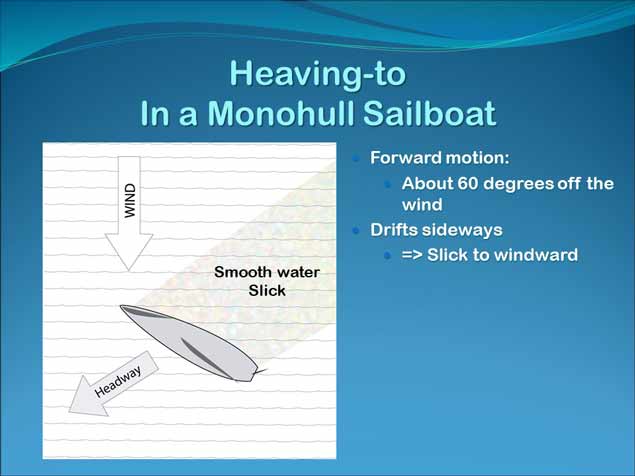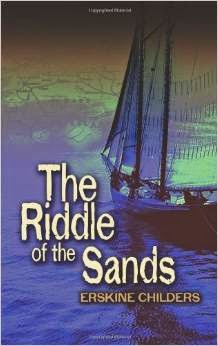Managing heavy weather at sea
Yesterday, we addressed a conference of about 100 cruisers at the Irish Sailing Cruising Conference. In 2008, on a crossing of the north Atlantic, we encountered six gales and managed to avoid one strong storm. What we learned then, we were here to share about our experience with storm management. The conference was summarized overall in Afloat magazine.

Following is an overview of our talk:
 When a weather window opened up, the Blackwells left Nova Scotia under
thick fog in about 15 knots of breeze. The fog persisted along the entire coast
of Newfoundland, which they never saw, until they crossed the Labrador Current.
Until then, they had sailed under full sail. Afterwards, the wind started to
build.
When a weather window opened up, the Blackwells left Nova Scotia under
thick fog in about 15 knots of breeze. The fog persisted along the entire coast
of Newfoundland, which they never saw, until they crossed the Labrador Current.
Until then, they had sailed under full sail. Afterwards, the wind started to
build.
They have several rules they go by:

Following is an overview of our talk:
Managing Offshore Storms
by Alex and Daria Blackwell
In 2008, Alex and Daria Blackwell left their jobs, loaded up their boat
and sailed across the Atlantic. They cruised Maine and Nova Scotia in Aleria, their Bowman 57 cutter rigged
ketch, before heading out to sea. Alex,
a master mariner and Daria, a licensed captain, had never crossed an ocean
before but had been sailing for many years, including weeklong coastal
passages, and did a great deal of preparation in advance.
But 2008 was an unusual year. Not only did the markets collapse around
the world while they were out at sea, the North Atlantic had more heavy weather
that year than would typically be expected. In the three weeks it took them to
sail across from Halifax to Westport, they experienced six gales and managed to
avoid one strong storm with potentially life threatening conditions. They
gained a good deal of experience on that crossing and have since crossed the
Atlantic twice more as well as having sailed to Scotland and Spain and along
the west coast of Ireland many times, never again seeing the type of weather
the North Atlantic had served up that year.
Since they survived, they were at the Irish Sailing Cruising Conference
to share what they had learned.
Daria first gave a general overview of how to think about the factors
that affect weather in the Atlantic. The ocean, being a conveyor belt for
water, has currents circulating around it. The Gulf Stream brings warm water up
the coast of the US that mixes with the cold Labrador current which brings cold
water and ice down from the Arctic. That continues to Ireland as the North
Atlantic Drift and then completes the loop with the Canary Current and North
Equatorial current.
Above the Atlantic sits the Azores High, a stable bubble of airmass.
Lows swoop down from North America and cyclones swoop up from tropical regions
where they form to circle around the Azores High. Of course Hurricane Ophelia
this year formed off the coast of Africa and headed directly North to Ireland
reminding us that climate change is making weather events less predictable and
more extreme. The trade winds also
circulate around this high pressure system creating the trade routes that,
together with the currents, enable ocean crossings.
Despite being an oversimplification, understanding weather patterns
during passage planning is essential. Many resources, like Passage Weather, are
available today to assist with planning a passage in advance. After departure,
however, other tactics are necessary.
It helps to develop a “weather eye” and keeping a log is important if
something untoward happens but is also vital to forcing awareness of changing
conditions. Timely response to changing conditions can mean the difference
between safety and comfort or survival management.
The Blackwells worked with the legendary Herb Hilgenberg, now retired,
who provided weather routing via SSB radio while they were underway. Herb
helped them interpret the forecasts for their region and provided suggestions
for the best routes to take advantage of the conditions and avoid undesirable
ones. It pays to enlist the help of shore-based experts to help interpret the
weather files, called GRIBS, one can download via SAT phone and SSB radio. There
are many services available.
 When a weather window opened up, the Blackwells left Nova Scotia under
thick fog in about 15 knots of breeze. The fog persisted along the entire coast
of Newfoundland, which they never saw, until they crossed the Labrador Current.
Until then, they had sailed under full sail. Afterwards, the wind started to
build.
When a weather window opened up, the Blackwells left Nova Scotia under
thick fog in about 15 knots of breeze. The fog persisted along the entire coast
of Newfoundland, which they never saw, until they crossed the Labrador Current.
Until then, they had sailed under full sail. Afterwards, the wind started to
build.
1.
Stay on the boat – that means never leaving the companionway to go on
deck without being tethered to the boat. Sailing short-handed means that if
someone goes overboard, the likelihood of recovery would be slim.
2.
The time to reef is when you first think about it. Often people make
the mistake of waiting until conditions deteriorate when it becomes dangerous.
3.
Prepare in advance. Lack of preparation is an underlying factor in
disaster.
When the squalls started, they followed their direction and speed on
radar, but always made preparations in advance. Wind can go from 5 knots to 30
knots in seconds, and being caught unaware can result in a knockdown.
As the first gale approached, they had the following choices:
1.
Sail on
2.
Deploy a sea anchor or drogue
3.
Run with the wind
4.
Lie a-hull
5.
Heave to
As every boat is different, the Blackwells had experimented with
various methods and determined that heaving to in a storm situation to let the
storm pass over more quickly was their best bet on Aleria. Sailing on in a
storm is what racers do. This can cause a lot of stress on rig and crew. As cruisers
the Blackwells don’t subscribe to such discomfort.
Deploying a sea anchor puts great stress on deck hardware and can be
dangerous to deploy on a pitching deck and difficult to retrieve afterwards. In
addition, there is evidence that the stretching and contracting of the rode in
these extreme circumstances will cause internal abrasion in the fibres of the
rope, potentially leading to catastrophic failure.
Running with the wind under bare poles or storm sails would require
hand steering to manage the mountainous seas, and that would be difficult with
only two people. The motion of the wave cause the boat to yaw severely from
side to side. If the boat tends to surf down the waves it is possible that the
bow will become buried in the wave trough which would cause the boat to
pitch-pole.
Lying ahull in which all sail is removed and the boat is left to its
own defences was deemed most at risk of the vessel broaching and getting
swamped in massive seas.
They had experimented with heaving to under benign conditions and
decided that this would be their best option.
Heaving to on many boats is achieved by tacking after reducing sail and
not releasing the headsail sheet. The headsail is therefore backed and
counteracting the force of the main sail. The helm is lashed or locked to
windward. The boat settles down on an angle of about 60 degrees off the wind
sailing at about 1-2 knots, slipping sideways, creating a slick upwind and smoothing
the seas. When hove to, a degree of stability and calm is achieved that is
astounding.
The Blackwells sailed on through the first gale in which wind was in
the range of 35 knots gusting over 40. Their boat did well under staysail and
mizzen alone. When the wind built to more than 40 knots and the sea state built
to 30 feet with cresting waves and foam in the second gale, they opted to heave
to. For 36 hours, the gale raged overhead while they read books. After the
gale, they released the headsail sheet and then tacked through to get back on
course. The key here was to time manoeuvres with the seas. “We noted that waves
in this gale were coming in sets of 3 of about 20 feet and the 4th
would be an outlier of 30 to 40 feet. So we timed our tack for just after the
fourth wave to give us the best chance of not broaching if caught beam on.”
But the gales were unrelenting. They sailed through another and then
opted to heave to again. Half way through that gale Daria called out “I can’t
take it anymore, let me off at the next stop.” When Alex remarked that they had
forgotten to bring cookies along, Daria took to baking peanut butter cookies,
it was that calm aboard.
Daria explained that a quote by Donald Hamilton summed it up for her, “Being
hove to in a long gale is the most boring way of being terrified I know.”
Having a good library aboard made all the difference in the world.
On yet another occasion, heaving to may not have sufficed. Herb advised
the Blackwells to turn back and sail west for a day to allow a strong storm to
pass their track. With yet another gale approaching Alex being frustrated did
not heed the warning and sailed into the worst conditions they had experienced
yet, confirming that indeed the weather routers know what they are doing. Aleria hove to for a third time before
finally heading into Clew Bay.
The Blackwells explained that heaving to is not just useful in storm
situations. Heaving to can also assist with:
·
Reefing or dropping the mainsail
·
Making repairs in less challenging conditions
·
Adding fuel to the tanks
·
Having lunch in more peaceful conditions
·
Rendezvousing with a dingy
·
As a viable MOB manoeuvre
The most important consideration is to practice under benign conditions
to determine how your boat responds. Some vessels, like catamarans, heave to
best with one sail alone.
Several members of the audience confirmed the effectiveness of heaving
to. One experienced sailor told a story of being caught in a storm on a
delivery where the owner refused to heave to. He finally relented when
conditions became unbearable and now swears that it was the best thing he’s
ever learned.
An RNLI lifeboat crew member informed the group that he had just been
at a seminar in which the rescue helicopter service now request sailboats to
heave to on port tack if a rescue is underway because their equipment is
deployed from the starboard door. They have determined that heaving to is the
most effective means by which to stabilise the vessel and keep the mast from
getting caught up with their gear.
Participants were left thinking about their options and planning their
next opportunity to practice heaving to.
~~~~~~~~~~~~~~~~~
Alex is Rear Commodore for Ireland of the Ocean Cruising Club, a
Committee member and newsletter editor of the Irish Cruising Club and Committee
member of Mayo Sailing Club. Daria is Rear Commodore of the Ocean Cruising
Club. Alex and Daria are co-authors of Happy
Hooking the Art of Anchoring and Cruising
the Wild Atlantic Way.



Comments
Post a Comment